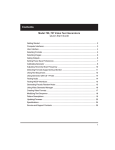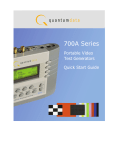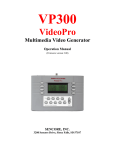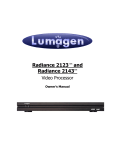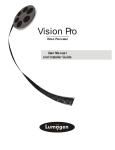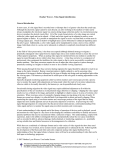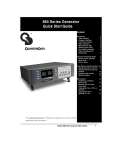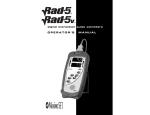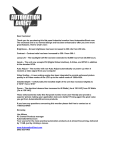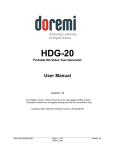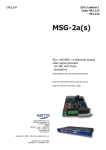Download Quantum Data 701 Specifications
Transcript
700 Series Portable Video Test Generators Quick Start Guide Contents Model 700, 701 Video Test Generators Quick Start Guide Getting Started ........................................................................................................... 2 Computer Interfaces.................................................................................................... 3 User Interface ............................................................................................................. 4 Selecting Formats ....................................................................................................... 5 Selecting Images ........................................................................................................ 6 Gating Outputs ............................................................................................................ 6 Setting Power Save Preferences ................................................................................. 7 Calibrating Generator .................................................................................................. 8 Adjusting Horizontal Scan Frequency ........................................................................ 10 Detecting Formats Supported by a Monitor ............................................................... 11 Using Test Sequences ............................................................................................... 12 Using Generator with CS-1 Probe .............................................................................. 14 Testing Audio ............................................................................................................ 14 Testing HDCP Interfaces ........................................................................................... 15 Generating Psuedo Random Noise ............................................................................ 15 Using Video Generator Manager ................................................................................ 16 Creating Video Formats ............................................................................................. 17 Modifying Test Sequence .......................................................................................... 18 Pattern Descriptions .................................................................................................. 19 Updating Firmware .................................................................................................... 23 Specifications ........................................................................................................... 24 Service and Support Contacts .................................................................................. 25 Getting Started Using AC Power Use only the AC adaptor provided with the generator to avoid operator injury and damage to the generator. Using Battery Power The generator uses six AA rechargeable nickel metal hydride (NiMH) batteries, which can be recharged about 1000 times. You may use alkaline batteries instead, but not while the AC charger is connected to the generator. Only NiMH batteries can be safely recharged in the generator. All batteries in the generator must be the same type. The supplied batteries may not come fully charged. Use the supplied AC charger to charge the batteries for at least 18 hours. The AC adaptor may be used to operate the generator and to recharge the batteries at the same time. With fully charged batteries, the generator should operate for about 8 hours using VESA mode. Using the LCD backlight, DVI, NTSC/PAL, or RF features will reduce the battery life. The generator displays a low battery message when the NiMH batteries need recharging, or when the alkaline batteries need to be replaced. 2 Computer Interfaces DVI-I 1 8 9 16 17 Pin 1 2 3 4 5 6 7 8 9 10 11 12 13 14 15 Signal TMDS data 2TMDS data 2+ TMDS data 2/4 shield 24 Pin 16 17 18 19 TMDS data 420 shield 21 TMDS data 4+ 22 DDC clock 23 DDC data 24 Analog vertical sync TMDS data 1TMDS data 1+ TMDS data 1/3 C1 shield TMDS data 3C2 TMDS data 3+ C3 +5V power C4 Ground C5 S-Video C1 C2 C5 C3 C4 Signal Hot plug detect TMDS data 0TMDS data 0+ TMDS data 0/5 shield TMDS data 5TMDS data 5+ TMDS clock shield TMDS clock+ TMDS clock- Chrominance (C) Luminance (Y) Ground Ground NTSC/PAL BNC NTSC/PAL RF (Active on 701 only) Stereo Audio - 3.5 mm phone jack Analog red Analog green Analog blue Analog horz sync Analog ground Tip Ring Sleeve Left channel (1 KHz) Right channel (2 KHz) Ground DVI interface on 700 outputs analog signals only, using included DVI-to-VGA adaptor. RS-232 9-Pin D-Sub Plug Pin 1 2 3 4 5 6 7 8 Signal No connection Data in (Rx) Data out (Tx) DTR out Ground No connection RTS out CTS in Factory defaults 9600 baud 8 data bits No parity 1 stop bit X on - X off External DC Power / Battery Recharge Input Center pin: Outer sleeve: +12.0 VDC - (Ground) Warning: Using an external power source other than the Quantum Data supplied AC power supply may injure the operator and damage the generator. Pinout same as for 9 pin PC-AT serial port connector 3 User Interface LCD Display The LCD window displays messages and menu options. Asterisk indicates active menu item. Item 1 Item 2 Item 5 _Item_1______Item_5* _Item_2______Item_6 _Item_3______Item_7 _Item_3______Item_8 Item 3 Item 6 Item 7 Item 8 Item 4 Buttons activate items in current menu list. Use +/ buttons below to scroll menu screens when more than 8 items available. Function Buttons ON/OFF Toggle generator power on and off IMAGE FORMAT Menu of available test images. Menu of available video formats (set-ups) of the selected signal type. TEST Menu of available testing modes. CHARGE External power source (charger) connected when lit +/ON/OFF FORMAT IMAGE TEST CHARGE GATING Menu for gating video and sync compontents on and off BACKLIGHT Toggle LCD backlight on and off. Goes out 20 seconds after any button press on batteries. Stays on when using external power GATING BACKLIGHT SIGNAL TYPE SIGNAL TYPE Menu for which format types are shown by FORMAT button OPTIONS LEARN MONITOR OPTIONS Menu of generators configuration options. Page through menu screens when more than 8 items available LEARN MONITOR Obtain EDID data from unit under test via DDC connection. 4 Selecting Formats Viewing Formats by Signal Type Press the Signal Type button, and then select a signal type, to list formats based on the selected signal type. VESA Red, green, blue component color video per VESA standards. (DVI-to-VGA adaptor used for outputs.) *VESA _NTSC/PAL _HDTV/SDTV RGB _HDTV RGB DVI USER NTSC/PAL Composite color baseband video signal (BNC connector) and Separate Luminance and Chrominance video signals (S-Video connector) or RGB component video per NTSC and PAL standards. Names of formats using modulated RF output end with _Cnn, where nn is the NTSC-M or PAL-G television channel used. HDTV/SDTV-RGB HDTV RGB DVI Luminance plus color difference signals per HDTV standards RGB component color video signals per HDTV standards Digital video signals (701 only) USER User-defined formats, of any type, stored in non-volatile memory Selecting Formats Press the Format button to select from a list of video formats of the type selected from the Signal Type menu. Reloading Standard Formats If you modify or delete standard formats, you can restore the original formats by reloading the standard formats. To reload the standard formats: 1. Select Options > Clr_Fmts to delete all formats, including user-created formats. 2. Select Options > Reload Fmts to restore the standard formats to their original memory locations. The standard formats will replace any user-created formats in the original memory locations. User-created formats in locations not previously occupied by a standard formats will not be replaced. 5 Selecting Images Selecting Images Press the Image button to select from list of available test images (patterns). *CutOff________ _GrayBar _Window Regulate _Focus Checker _ColorBar______ Dot_12 You cannot modify the images, or add your own images. Gating Outputs Press the Gating button to gate outputs, and to switch sync types. Note: Color gating works for all images except Ramp. Red Color Component ON/OFF Green Color Component ON/OFF Blue Color Component ON/OFF *RED__ *GRN *BLU__ GATING___ _ACS_ Format _ __ DCS_ Image _ ___ DSS* _____ OUT* Current format Current image ACS - Select Analog Composite Sync (Composite Video) DCS - Select Digital Composite Sync DSS - Select Digital Separate (H&V) Sync OUT - All test signal outputs ON/OFF 6 Setting Power Save Preferences Options Menu Press the Options button to set system-level options. Power Save - Sets Power Saver preference Pwr Save:On NTSC_CAL___ Clr_Fmts__ Calibrate Calibrate - Displays calibration menu for setting RGB analog video and sync amplitudes. Appears only if the generator has been configured to allow recalibration. ReloadFmts Reload Fmts - Restores factory default formats NTSC_CAL - Displays calibration menu for setting peak white signal on the TV output BNC connector Clr Fmts - Clears all formats from user memory Setting Power Save Preference When the Power Save preference is on, and the generator is on battery power, the generator will turn off after 30 minutes of no front panel activity. If the generator is running a test sequence in Burn-in mode, the Power Save preference is ignored. To set the Power Save preference, select Options > Pwr Save. 7 Calibrating Model 700 and 701 generators use programmable hardware to set the amplitude calibration factors for analog video outputs. These calibration factors are stored in Flash EPROM, and are not lost if the batteries are run down or removed. Quantum Data calibrates the analog video and sync output amplitudes in new generators to published specifications. You can recalibrate these amplitudes over a nominal range to meet your specific testing conditions. WARNING: Recalling the original factory calibration settings is not possible after saving your own settings. Equipment Needed for Calibration • DC voltmeter capable of measuring from 0 to 1 volt with a minimum resolution of 2 millivolts • Precision 75 ohm (+/- 1%) input terminator for the voltmeter • Test cable to connect the voltmeter to the R, G, B and ground pins on the VGA connector • Oscilloscope with a precision 75 ohm (+/- 1%) input impedance and suitable gain and bandwidth to display a 1.00 Volt pk-pk signal with 3.579 MHz color carrier • 75 ohm coaxial cable to connect the oscilloscope to the BNC TV output • Vector scope 8 Calibrating Calibrating Outputs 1. Select Options > Calibrate > Reset to set the generator’s calibration factors to default nominal values. 2. Press Options > Calibrate > Full Scale. 3. Set the voltmeter’s scale factor to be able to measure a nominal 1000 millivolts DC. 4. Using a VGA-to-BNC cable, connect the generator’s red output to the positive input on the voltmeter, with a 75 ohm (+/- 1%) input terminator. Connect the negative lead of the meter to any ground pin. 5. Select R_FS+ or -R_FS to set the DC output level to 1000 mV +/- 3 mV. 6. Repeat steps 4 and 5 for the green and blue outputs. 7. Select Save. 8. Select Options > Calibrate > Zero. 9. Connect the red output to the positive input of the voltmeter. _____ Calibrate _ _Full_Scale____ _Reset _R_FS+_____ _G_FS+_______ _B_FS+_______ _Save_________ _R_Zero+____ _G_Zero+____ _B_Zero+____ _Save__________ Zero ___-R_FS _-G_FS _-B_FS _Back -R_Zero -G_Zero -B_Zero Back 10. Select R_Zero+ or -R_Zero to set the DC output level to 0 mV +/- 3 mV. 11. Repeat steps 9 and 10 for the green and blue components. 12. Select Save. 13. Select Options > NTSC_CAL. 14. Adjust the oscilloscope's timebase and sweep trigger to view the entire waveform. Adjust the G_NTSC so that its chrominance is 100 IRE or 714mV. 15. Using a vector scope, use the R_NTSC and B_NTSC options to adjust the red and green outputs using so that their signals align with the 2% boxes. 16. Press Save. Note: The modulated RF output does not have any calibration settings. 9 Calibrating Locking Calibration Settings The generator uses an internal hardware jumper to enable and disable changes to calibration settings. If the Options > Calibration option is available, the jumper is set to enable re-calibration. To prevent users from changing calibration settings: 1. Turn the generator off, and remove the back cover. 2. Locate the J10 jumper, which is near the lower-right corner of the board. 3. Connect the jumper to only one pin to disable user calibration. Connect both bins to enable user calibration. 4. Install the back cover. Adjusting Horizontal Scanning Frequency Select Test > Freq Shift, and then press the +/- buttons to increase or decrease the horizontal scanning frequency of the current video format +/- 10% in 2% increments. The ^ character indicates the percent deviation. The bottom number is the actual frequency. _____Freq. Shift -10%_-----+-----_+10 __________^ __H= +31.469E+03 10 Detecting Formats Supported by a Monitor Learn Monitor If the generator is connected to a VESA DCCcompliant display, press the Learn Monitor button to view formats supported by both the display and generator. _______Reading _____Monitor EDID _______COMPLETE Details To view the format names, select the Details option after the generator completes reading the EDID (Extended Display Identification Data) data. The display’s EDID data may include Show details of EDID non-VESA formats, which are not listed. You cannot select formats from this list, but the DDC Step feature can be used to test the listed formats (page 13). after successful read back from display under test Complete indicates EDID data was read back correctly. Failed indicates unable to read back valid EDID data 11 Using Test Sequences Test Menu Press the Test button to select special test operating modes. Sequence Mode Sub-Menu Burn-In Mode Sub-Menu _Sequence______CS1 Probe _Burn-In DDC_Step _Freq Shift _Audio PR Noise Freq Shift Mode Sub-Menu Probe CS-1 Readings Sub-Menu DDC Step Mode Sub-Menu Audio Set-up Sub-Menu Running Test Sequence Manually The generator includes a test sequence, which specifies a series of format and image combinations. To run the test sequence, select Test > Sequence > Run, and then press the +/- buttons to step through the sequence. Use the menu buttons to gate video color information, change sync types, and turn all signal outputs on and off. You can use VGM to modify the test sequence (see page 17). ASC - Select Composite Analog Sync (Composite Video) Red Color Component ON/OFF Green Color Component ON/OFF Blue Color Component ON/OFF _Red__SEQ_NAME__ACS _Grn__Step#xxx__DCS _Blu___Format___DSS* _______Image____OUT* DCS - Select Digital Composite Sync DSS - Select Digital Separate (H&V) Sync OUT - All test signal outputs ON/OFF Line Line Line Line 1: 2: 3: 4: Name of Test Sequence currently running. Current step number in sequence Video format used in current step Test image used in current step 12 Using Test Sequences Running Test Sequence in Burn-In Mode Select Test > Burn-In > Run to automatically cycle through the test sequence. When the Burn-In mode is stopped, you can use the menu buttons to gate video color information, change sync types, and turn all signal outputs on and off. NOTE: The Burn-In mode disables the Power-Save feature, if enabled. OUT - All test signal outputs ON/OFF Run - Press to run Burn-in. Stop - Press to stop _Run___Burn-In__OUT* _Red___step#1___DSS* _Grn___800_@60__DCS_ _Blu___Focus____ASC Red Color Component ON/OFF Green Color Component ON/OFF Blue Color Component ON/OFF DSS - Select Digital Separate (H&V) Sync DCS - Select Digital Composite Sync Line Line Line Line 1: 2: 3: 4: Name of Burn-in test currently running. Current step number in cycle Video format used in current step Test image used in current step ASC - Select Composite Analog Sync (Composite Video) Creating Test Sequence for DDC Displays If the generator is connected to a VESA DCC-compliant display, press the Learn Monitor, and then Test > DDC Step to setup a test of each format supported by the display. Press the + button to render the current image with each video format supported by the display. Press the - button to render all images at the current format. Select the Run option to automatically test all images for each video format. When using automatic mode, select Stop to use manual mode. 13 Special Tests Using Generator with CS-1 Probe The Test > CS1 Probe option uses the Quantum Data CS-1 color sensor to measure the chromaticity and luminance (brightness) of a display. The CS-1 probe connects to the generator’s serial port. Chromaticity is shown as x,y C.I.E. coordinates and the luminance (Y) can be shown either in units of foot-Lamberts or nits. The CS-1 needs to be over a fully lit white area of the display for accurate readings. The Flat_Wht test image is suitable for use with the CS-1 Read - Take new reading. Error codes: ______Y:_24.141_fL ______x:_.293 ______y:_.279 _Read_______fL/nits fL/nits - Toggle between footLamberts and nits for units of measure and take new reading. 1, 7 - CS-1 not seeing a usable test image. 5, 8 - Generator did not find a CS-1 probe. 2, 3, 6 - Probe malfunctioning. Testing Audio Select Test > Audio to independently toggle stereo audio output channels on and off. On a 701 generator, the left channel is also the monophonic audio source for the modulated RF output. Testing HDCP Interfaces Model 701 video test generators may be equipped with an optional production (private) key for testing High-bandwidth Digital Content Protection (HDCP) interfaces of DVI receivers that support HDCP. For more information about HDCP, see http://www.digital-cp.com/. To output HDCP-encrypted video content: 1. Connect the DVI connector of the generator with the DVI connector of the device under test. 14 Special Tests 2. Choose a DVI video format supported by the device. 3. Press Test > HDCP > Start to output HDCP encrypted content. The display on the generator indicates if the test passed or failed. If the test passed, the currently selected pattern is displayed on the device under test. Noise is displayed if the HDCP authentication failed. After the initial authentication of the connection is established, the generator displays the number of authentication verification cycles until you stop the test. During the test, if you reconnect the cable or restart the device under test, the test should restart automatically. 4. To stop the test, press the Exit soft key or any gray key. Generating Pseudo Random Noise When the generator is connected to a device that supports the Quantum Data pseudo random noise standard, press Test > PR Noise to output the noise pattern as a static image. Depending on how the device is designed, it may compare the pattern output by the generator with an identical pattern, created internally, to detect errors in the cable and in the device itself. 15 Using Video Generator Manager About VGM Video Generator Manager (VGM) is a Windows-based application for creating and editing formats and test sequences. As many as 132 formats and one test sequence can be stored in the generator. VGM was originally created for use with Quantum Data 80x video generators. The 700-Series generators support only some VGM features. For information about using VGM, see the VGM help file. VGM Quick Tour 1. Connect the generator to your computer using a null modem serial cable. Note: You may not be able to connect to the generator when it is Power Save mode. 2. Start VGM, and then select Generator > Connect. 3. In the Select Port dialog box, select the Serial option, and then click OK. The name of the connected generator is listed in the bottom half of the VGM window. 4. Click the View Formats icon to view the formats available in the generator, and then double- click the format you want the generator to use. 5. Click the Image List icon to view the available images, and then double-click the image you want the generator to use. 16 Creating Video Formats Editing Video Formats You can use VGM to create your own video formats. You can start with a default format in the VGM format editor, or copy an existing format. To create a video format: 1. Connect the generator with VGM, and then double-click the generator name. 2. Click the View Formats icon to list the available formats. 3. Right-click a format that is similar to the format you want to create, then select Copy to create a copy of the format. The name of the new format is based on the original format, followed by an underscore and number. 4. Right-click the copied format, select Edit, and then click Yes to open the Format Editor. 5. Specify the format parameters. The format editor works as described in the VGM help file, except that the physical size entries have no affect on how test images are displayed on the 700 series. However, the integer portion of the horizontal size in millimeters specifies the storage location of the format in the generator. Unlike our other models, the 70x generators store formats by specific numeric locations, and not by name. If you do not change this number, the edited format will replace the previous version of the format when you upload it back to the generator. You will not get any warnings that you are about to overwrite a memory location. 6. Select File > Save to save the format on your PC, and then close the Format Editor window. 7. In the VGM data pane, select the format, and click the Send Data icon to store the format on the generator. 17 Modifying Test Sequence Editing the Test Sequence The generator has a default sequence, which you can edit in VGM. One sequence can be stored in the generator at the same time. To modify the test sequence: 1. Connect the generator with VGM, and then double-click the generator name. 2. In the generator window, click the Sequence List icon 3. Right-click the sequence name, and then select Edit to open the Sequence Editor. 4. Select the 70x generator from the Generator list. Do not select the virtual generator. 5. Modify the test sequence. to display the sequence name. VGM help describes the basic operation of the Sequence editor. Specify only a format and image for each step. Do not use the No Change value. The 700-Series generators do not support the output gating and sync options, and the No Change value. 6. Select Edit > Edit Sequence Name to save the sequence as a new sequence file. 7. Select File > Save to save the sequence on your PC, and then close the Sequence Editor. 8. In the top half of the main VGM window, select the sequence, then click the Send Data icon to store the sequence on the generator. To run the test sequence, see page 12. 18 Pattern Descriptions Flat_Wht/(R,G,B) Description - Fills the screen with white, blue (B), green (G) or red (R). Application - Use to test chrominence. Grid Description - White crosshatch on a black background. The lines form square boxes. A single pixel dot is located in the center of each crosshatch box. Application - Use the Grid pattern to test convergence. To accurately produce an image on a color monitor, the three electron beams in the CRT must meet (converge) at the same location at the same time. Lines displayed on a misconverged monitor appear as several multi-colored lines, and the transitions between different colored areas contain fringes of other colors. Rev_Grid Description - Black crosshatch drawn on a white background. The lines form square boxes. Application - Use to test convergence. To accurately produce an image on a color monitor, the three electron beams in the CRT must meet (converge) at the same location at the same time. Lines displayed on a misconverged monitor appear as several multi-colored lines, and the transitions between different colored areas contain fringes of other colors. Overscan Description - The image has three parts. The first part consists of five white circles. A large circle is drawn in the center of the screen. Its diameter equals the lesser of the video height or width of the display. A circle also is drawn in each of the corners of the screen. The diameter of the corner circles equals one-fifth of the display width. The second part of the image consists of a white crosshatch. The number of boxes in the crosshatch depends on the physical size of the display. The last part of the image consists of white tic marks on the horizontal and vertical center lines of the image. The marks are one pixel thick. Every other mark is slightly longer. The color of the pattern can be changed with the individual video output controls. Application - Used for detecting non-uniformity and non-linearity. The image presents an undistorted display, the horizontal and vertical sweeps of the electron beam across the face of the CRT should be at uniform speeds. Any non-uniformity in the sweep causes portions of an image to stretch while other portions are compressed. Non-linearity in a monitor shows up in several ways. It may be present across the entire screen, in a large portion of the screen, or localized in a very small area. 19 Pattern Descriptions Raster Description - Black display (nothing being displayed). Application - Useful for centering the raster on a CRT. Many monitor applications require that the displayed image or text fit completely within a bezel that surrounds the CRT. This usually requires that you first center the blank raster on the face of the CRT, and then center the image within the raster. Cutoff Description - The entire active video area is filled with a shade of gray. Application - Useful for testing chrominence and contrast. Window Description - Single white box in the center of active video. The size of the box is one-third the width and height of the active video area. Application - Use for brightness control adjustment. Focus Description - This image fills the screen with white M characters. Application - Used for testing focus. ColorBar Description - The image has 7 full-height vertical color bars. Application - Useful for verifying that none of the video channels are bad or connected incorrectly. GrayBar Description - The image has 16 full-height vertical graybars. The intensity of the bars increases from left to right. All bars are untined gray at all levels. Application - Useful for testing brightness control adjustment and brightness uniformity tests. 20 Pattern Descriptions Regulate Description - The image has a pair of white outlined boxes which surround a blinking solid white box. Application - Tests for proper high voltage regulation. Checker Description - The image’s active video area is equally divided into a 6x6 checkerboard of black and white boxes. Application - The pattern is based on a proposed ANSI method of measuring the contrast ratio of video projection systems. Dot_12 Description - The image’s active video area is filled with multiple rows of white, single pixel dots. The dots define the corners of what would appear to be square boxes if all connecting pixels were lit. The number of rows of boxes and the number of boxes per row depends on which version of the image is selected and the screen aspect ratio of the currently-loaded format. Application - Used to measure convergence. To accurately produce an image on a color monitor, the three electron beams in the CRT must meet (converge) at the same location at the same time. Small dots displayed on a misconverged monitor appear as a group of multi-colored dots. SMPTEBar Description - The image’s upper 67% of the image consists of a series of color bars. These bars match the order of the bars in the SMPTE and EIA patterns. The left side of the lower 25% of the image contains isolated -I and Q color difference signals that match the original EIA and SMPTE patterns. The -I signal appears as a bluish-gray bar and the Q signal appears as a purple bar on a TV monitor. The bars are separated by a white (+100 IRE) bar. After the Q blocks there are four blocks: black, (black - 4 IRE), black, (black + 4IRE). The right side of the lower 25% of the image contains a narrow 12.5 IRE gray bar. Application - Designed for adjusting the color settings of a television monitor by eye. It can also be used with a TV waveform analyzer and vectorscope for testing video signal processors and color decoders. 21 Pattern Descriptions Ramp Description - This image provides an active video area starting from full black (+7.5 IRE for NTSC) at one edge of the screen to full white (+100 IRE) at or near the opposite end of the screen. Application - Useful for testing pixel anomalies and chrominance. PulseBar Description - The image looks like two vertical lines followed by a wide vertical bar on a display’s screen. The first line is a red pulse. The pulse is 20 T for PAL and 12.5 T for NTSC formats. The second narrower line is a 2 T white sine-squared pulse. T = 100 nSec for PAL and 125 nSec for NTSC formats. The wide bar is white with sine-squared edges. Application - This image is intended for TV formats, but can be displayed with any format up to 100 MHz. Burst Description - The left side starts with reference white and black levels. This is followed by six bursts of square waves. Each burst is at a different frequency, forming vertical lines of various widths. The frequencies, going from left to right, are 0.5, 1, 1.53, 2.04, 3.06 and 6.13MHz. Application - The image can also be used with a TV waveform analyzer to check the frequency response of a video system. One scan line of the image, as it would appear on a waveform analyzer. High frequency roll-off (loss) would show up as a decrease in the peak-to-peak swings on the right side of the waveform. Low frequency roll-off would show up as a decrease in the peak-to-peak swings on the left side of the waveform. 22 Updating Firmware Updating Firmware The generator’s operating system firmware is stored in Flash EPROM, which you can update via the serial port. Firmware updates are available from http://www.quantumdata.com/support/downloads/. To install a firmware update: 1. Turn off generator, and connect it to your PC using a null modem serial cable. 2. Hold down the upper-right menu button, and then press the On/Off button. The LCD screen will indicate that the generator is ready for the upload. Pressing the upper-right button during startup sets the serial port at 19200 bps. To set the serial port at 9600 bps, press the upper-left button while turning on the generator. 3. If necessary, expand the .zip archive file that contains the firmware update. 4. If you have HyperTerminal, double-click the HyperTerminal setup file (QD70x Upgrade.ht) to start HyperTerminal with the proper communications setup (9600 bps, 8 data bits, no parity, 1 stop bit, Xon/Xoff flow control). Note: You may not be able to connect to the generator when it is in Power Save mode. If you are using a COM port other than COM1, choose File > Properties to select the desired COM port. HyperTerminal Private Edition is recommended when using Windows 2000 to install firmware. 5. In HyperTerminal, select Transfer > Send Text File. 6. In the Send Text File dialog box, double-click the firmware filename to start the transfer. The generator will display the progress of the update, which takes several minutes, and then restart to complete the installation. If you need to cancel the installation, select Exit. 7. If the firmware update includes new or revised video formats, press Options > Clear Fmts, and then select Yes to delete the current formats. Then press Options > Reload Fmts to load the new formats. 23 Specifications Video Formats Storage: 132 total Press Signal Type button to view signal types. Edit method: Windows-based VGM software Test Images (Patterns) Press Image button to list images. Horizontal Timing Frequency: 1 KHz to 250 KHz Total pixels: 144 to 4096 Active range: 16 to 4096 pixels VESA EDID/DDC Support Reads a monitor’s EDID data through DVI connector, and shows list of supported standard formats. DDC test mode for cycling through supported standard formats. Battery Power Operation Type: Six AA 1500 mA-H rated rechargeable NiMH batteries (included) Use time: 8 hours with fully charged NiMH batteries. Less when using backlight, DVI, NTSC, or RF features. Vertical Timing Frequency: 1 Hz to 650 Hz Active lines: 1 to 4096 Scan types: Progressive, 2:1 Interlace Sync Types Separate digital horizontal and vertical Digital and analog composite Bipolar HDTV Video Outputs Timing accuracy: 2% Connectors: AC Power Operation Type: External charger/power supply supplied with unit Input: 100-240 VAC @ 47-63 Hz Output: 12V Size and Weight Size: H 5.5 x W 8.25 x D 2 inches H 140 x W 210 x D 51 mm Ship weight: 4 lbs, including batteries See diagram on page 3. RF Output (701 only) Channels: Channels 2, 3, 4, and 6 (VHF) per NTSC (M) and PAL (G). Video: Color per NTSC (M) and PAL (G) Audio: Mono 1 KHz tone per NTSC (M) and PAL (G) Connector: Female F type Digital Video (701 only) Pixel rate: Single link 75 MHz Audio Outputs Connecter: 3.5 mm stereo phone jack Signals: Left: 1 KHz tone Right: 2 KHz tone User Interface Display: 4 x 20 character backlit LCD Buttons: 9 function buttons, 8 menu buttons, 2 paging buttons Computer Interface Type: RS-232, 9 pin D-sub Protocol: 9600 baud, 8-N-1, Xon/Xoff 24 Service and Support Contacts To contact Technical Support, see http://www.quantumdata.com/contact/support.asp. For factory-authorized service centers, see http://www.quantumdata.com/contact/locations.asp. Model 700, 701 Quick Start Guide 68-00198-D (12-Dec-2004) Copyright © 2006 by Quantum Data, Inc. All rights reserved. The information contained in this document is provided for use by our customers and may not be incorporated into other products or publications without the expressed written consent of Quantum Data. Information furnished by Quantum Data is believed to be accurate and reliable. However, no responsibility is assumed by Quantum Data for its use. Quantum Data reserves the right to make changes at any time and without notice to its products to improve performance, reliability, manufacturing methods, and (or) marketability. Documentation based on firmware version 1.6.0. Declaration of Conformity Manufacturer’s Name: Manufacturer’s Address: Quantum Data, Inc. 2111 Big Timber Rd. Elgin, IL 60123-1100; USA The manufacturer hereby declares that the product: Product Name: Model Numbers: Video Test Generator 700, 701 conforms to the following standards or other normative documents: CENLEC EN55022, RF Emissions: 1998 EN55022 Conducted Emissions, AC Mains (0.15-30 MHz) Class A EN55022 RF Radiated Emissions (30-1000 MHz) Class A CENLEC EN61326, Electrical Equipment for measurement, control and laboratory use - EMC Requirements: 1997 Complies with Sections Listed Above 89/336/EEC EMC Directive Supplementary Information The external power supply and power cord supplied with the unit are required for electromagnetic compatibility. Use of premium quality shielded cables is required for electromagnetic compatibility. When and Where Issued 07-September-2001 Romeoville, IL; USA Marks of Compliance 25



























